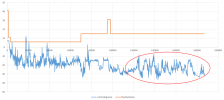You are using an out of date browser. It may not display this or other websites correctly.
You should upgrade or use an alternative browser.
You should upgrade or use an alternative browser.
Another mavic mini flyaway
- Thread starter aidworker
- Start date
It's really hard to analyse flight data when users have updated to app version 1.2.2 or later because DJI changed their encryption.Hello, my mavic mini flew away.
That means that we can't see much of the data to tell what happened.
But with the little that Airdata does show it's pretty clear that your drone blew away in a wind that was too strong for it to fly against.
When you allow your drone to be blown away, it's not right to say that it flew away.
Because it had plenty of battery left when signal was lost, and the wind was gusty and variable it's not possible to give an accurate idea of where it will have come down.
But a rough calculation would suggest it 2.3 miles or more to the east of where signal was lost.
Last edited:
Yogi053
Well-Known Member
"Athough the telemetry showed several strong wind warnings........"
I think that might have had something to do with it!
I think that might have had something to do with it!
Thanks for your feedback.It's really hard to analyse flight data when users have updated to app version 1.2.2 or later because DJI changed their encryption.
That means that we can't see much of the data to tell what happened.
But with the little that Airdata does show it's pretty clear that your drone blew away in a wind that was too strong for it to fly against.
When you allow your drone to be blown away, it's not right to say that it flew away.
Because it had plenty of battery left when signal was lost, and the wind was gusty and variable it's not possible to give an accurate idea of where it will have come down.
But a rough calculation would suggest it 2.3 miles or more to the east of where signal was lost.
Yet, I'm not sure I agree with your statement that "When you allow your drone to be blown away, it's not right to say that it flew away." I understand that RTH wasn't an option, but both sticks were dead and any attempt to fly it back, reduce altitude, land it, stop the rotors etc wasn't possible. I didn't have much options anyways. What would be a typical "fly away" case for you?
Right, but the warning is/was popping up even with winds <20 kph. I get your point, but it doesn't reflect the actual weather conditions of the flight in question. In any case, I have flown with stronger winds or gusts (even in way higher altitudes >2000 m) without an issue."Athough the telemetry showed several strong wind warnings........"
I think that might have had something to do with it!
The term flyaway suggests that the drone itself flew away but analysis of flight data from hundreds of flight incidents shows that drones don't just fly away at all.What would be a typical "fly away" case for you?
When people say flyaway they usually mean : I lost my drone but don't know why.
Yogi053
Well-Known Member
I accept the fact that you have flown at much higher altitudes and when you quote (>2000m) I hope you mean dstance and not height. (Possible height restriction hack).Right, but the warning is/was popping up even with winds <20 kph. I get your point, but it doesn't reflect the actual weather conditions of the flight in question. In any case, I have flown with stronger winds or gusts (even in way higher altitudes >2000 m) without an issue.
Do you not believe in VLOS at all?
Good point, but why do you think DJI offers Flyaway coverage with the mavic mini 2? They define flyaway as "situations aircraft goes missing during flight", and that really makes me wonder what's going on...The term flyaway suggests that the drone itself flew away but analysis of flight data from hundreds of flight incidents shows that drones don't just fly away at all.
When people say flyaway they usually mean : I lost my drone but don't know why.
Yogi053
Well-Known Member
"stop the rotors wasn't possible" Does this mean that the mini (original) does Not have the emergency shutdown like the Mini 2?Thanks for your feedback.
Yet, I'm not sure I agree with your statement that "When you allow your drone to be blown away, it's not right to say that it flew away." I understand that RTH wasn't an option, but both sticks were dead and any attempt to fly it back, reduce altitude, land it, stop the rotors etc wasn't possible. I didn't have much options anyways. What would be a typical "fly away" case for you?
I mean 2000 m asl, not agl, where air is quite thinner and the aircraft struggles even with the slightest wind gust. Due to it's low mass/weight, VLOS is my preferred mode for mavic mini. I have flown however BVLOS with my good ole phantom 3 many times, but only where conditions permit it.I accept the fact that you have flown at much higher altitudes and when you quote (>2000m) I hope you mean dstance and not height. (Possible height restriction hack).
Do you not believe in VLOS at all?
It has, but since the sticks were dead, the option wasn't available"stop the rotors wasn't possible" Does this mean that the mini (original) does Not have the emergency shutdown like the Mini 2?
Yogi053
Well-Known Member
Sorry, I haven't heard the term, 'sticks dead' before, so I don't/didn't understand the term.It has, but since the sticks were dead, the option wasn't available
I am sorry you lost your Mini. Have you thought about putting your flight log on here so one or two of the expert members can pinpoint more accurately what the cause of the 'flyaway' indeed was?
I am afraid the wind was really strong. The craft was in RTH mode ( flycStateRaw = 15 ) throughout the second half of the flight. The pitch angle was aroudn -25 degree ( ie, nose down ) on average and yet the craft was travelling backward at a speed of 15 mile/hour on average ( ySpeed in the chart ). Adding the air speed of 18 mile/hr at that pitch angle , the wind speed was 15 + 18 = 33 mile per hour which was way too strong for the little thing.
There has been a recent case in which the Mini issued false strong wind warning due to IMU problems but in your case this was unlikely to be the reason because there were a lot of "Not enough force / ESC errors" warnings as well indicating that the motors were really working hard to counter the wind but in vain.


There has been a recent case in which the Mini issued false strong wind warning due to IMU problems but in your case this was unlikely to be the reason because there were a lot of "Not enough force / ESC errors" warnings as well indicating that the motors were really working hard to counter the wind but in vain.


Last edited:
Yogi053
Well-Known Member
I have to admire the expertise of yourself and others of your 'ilk' that can take these graphs and, to me anyway, interpret them so easily. Maybe one day I will gain enough experience to do the same.
For boblui!
For boblui!
I was very disappointed to see DJI reinforcing the false idea that their drones are likely to fly away.Good point, but why do you think DJI offers Flyaway coverage with the mavic mini 2? They define flyaway as "situations aircraft goes missing during flight", and that really makes me wonder what's going on...
It's completely wrong and their "I lost my drone and didn't find it" insurance was introduced purely for commercial reasons.
They figure that enough timid flyers will pay for it because they are scared of losing their drone.
The number of forum threads discussing "flyways" only adds to this fear.
GerdS
Well-Known Member
There are also messages telling about poor GPS performance and later "no signal". This usually indicates that there might be a problem with compass calibration, too. At least the Mini has fallen back into Atti mode and then it is quite easy to blow it away.
It's hard to put together what happened with almost no description of your incident and only the Airdata report to use to reconstruct it.I understand that RTH wasn't an option, but both sticks were dead and any attempt to fly it back, reduce altitude, land it, stop the rotors etc wasn't possible. I didn't have much options anyways. What would be a typical "fly away" case for you?
There's no doubt that it was fighting a wind that was much too strong to make any headway.
If you are suggesting that the controller wasn't working, why not mention something so important?
The data shows that the drone was responding to your joystick inputs so you had full control and plenty of options (at the start of the flight.
Since you started on a high point, it would have been obvious that there was a significant wind and the direction would have also been obvious.
Just a minute into the flight the drone was showing that it couldn't fight the wind.
But you made no effort to lower the drone or even land when the drone was still less than 100 metres away.
Allowing the drone to go downwind in a significant wind and making no effort to get it out of the wind when it was possible is allowing the drone to be blown away.
The poor GPS message came at 2 seconds before the drone had acquired GPS,There are also messages telling about poor GPS performance and later "no signal".
The No Signal Message was after the drone was out of range and signal was lost.
The whole flight was carried out with very good GPS.
There was nothing to suggest any problem with the compass and the drone wasn't in atti mode at all for the flight.This usually indicates that there might be a problem with compass calibration, too. At least the Mini has fallen back into Atti mode and then it is quite easy to blow it away.
It blew away because the wind was much too strong.
Last edited:
Let me see if I am following this thread correctly.
OP states he had flyaway, said wind wasn't that bad (He was at what altitude as compared to aircraft?), says he had dead stick, said he did all he could do and CSC would have no effect.
Data Shows, no Fly away, wind at altitude was substantial and overcoming, Data shows full control of aircraft at all times, no systems errors of any kind..NO CSC attempted.
Ask for help analyzing, any suggestions on what might have gone wrong will be highly appreciated.
Questions why DJI would evoke and offer a coverage for such situations as data shows.
Fine people check data available and report, and OP says data was wrong as he had a P3 (not his first rodeo)....am I missing anything?
OP states he had flyaway, said wind wasn't that bad (He was at what altitude as compared to aircraft?), says he had dead stick, said he did all he could do and CSC would have no effect.
Data Shows, no Fly away, wind at altitude was substantial and overcoming, Data shows full control of aircraft at all times, no systems errors of any kind..NO CSC attempted.
Ask for help analyzing, any suggestions on what might have gone wrong will be highly appreciated.
Questions why DJI would evoke and offer a coverage for such situations as data shows.
Fine people check data available and report, and OP says data was wrong as he had a P3 (not his first rodeo)....am I missing anything?
Yep ... the wind was way over the top for a tiny Mini unfortunately... this was not so much more than a BlowAway.I am afraid the wind was really strong. The craft was in RTH mode ( flycStateRaw = 15 ) throughout the second half of the flight. The pitch angle was aroudn -25 degree ( ie, nose down ) on average and yet the craft was travelling backward at a speed of 15 mile/hour on average. Adding the air speed of 18 mile/hr at that pitch angle , the wind speed was 15 + 18 = 33 mile per hour which was way too strong for the little thing.
There has been a recent case in which the Mini issued false strong wind warning due to IMU problems but in your case this was unlikely to be the reason because there was a lot of "Not enough force / ESC errors" warnings as well so the motors was really working hard to counter the wind but in vain.
View attachment 122894
View attachment 122895
The wind indication from Airdata shows really strong winds (attached further below) ... but don't think it's all in this incident if nitpicking a bit.
If we just pick out the first period of RTH & look at that until the short period of Sports mode ...
RTH have the same spec as normal mode ... meaning it should be able to reach a 20 degree tilt ... it's not achieving that at all here... mostly show a bit more than 15 degrees.

Then checking the much shorter Sports Mode period ... in that mode it should be able to reach a 30 degree tilt, again that isn't achieved... start out with 15 & ends at just over 25 degrees during a very short period, but falls back & show a pitch instability.

It looks like this Mini ... as so many more, can't reach tilts according to spec. this most probably due to deformed props.
This defect makes the AC much more prone to drift with stronger winds as it can't tilt/pitch down enough to create speed & fight against the wind.
But looking at the wind speed indication from Airdata (which most probably is a tad on the high side due to the bad tilt performance) & the drift speed logged ... a fully performing Mini shouldn't have changed the outcome of this, the winds was way to strong ...

... and you flew out with the wind over a valley, & didn't do anything to save it... that sealed the outcome for this flight.

Similar threads
- Replies
- 23
- Views
- 3K
- Replies
- 39
- Views
- 7K
- Replies
- 20
- Views
- 1K
DJI Drone Deals
New Threads
-
Hiring Remote Drone Pilots and Support Staff with CrewBloom
- Started by felixleo
- Replies: 1
-
3 Along the road to my daughters former school
- Started by alex_markov
- Replies: 1
-
Last Week's Most Popular Topics (December 13, 2025)
- Started by msinger
- Replies: 0
-










